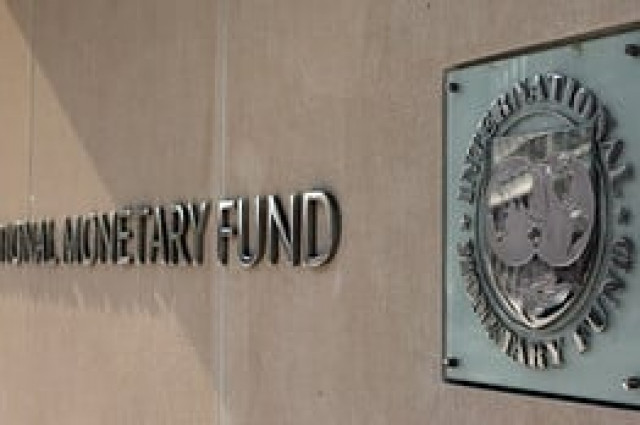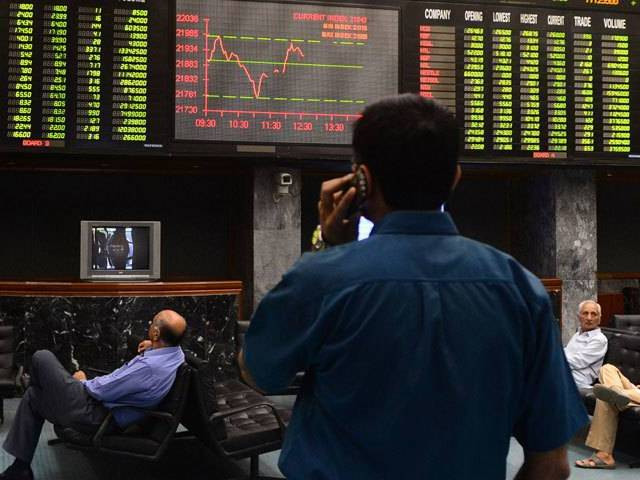Business
IMF warns global debt could hit 123% of GDP by decade’s end, nearing WWII levels | The Express Tribune

Warns of possible “disorderly” market correction that could trigger fiscal-financial “doom loop”
Global public debt is projected to rise above 100% of gross domestic product (GDP) by 2029, reaching its highest level since 1948 and continuing to climb, the IMF said on Wednesday, urging countries to build up buffers to guard against economic risks, Reuters reported.
Vitor Gaspar, head of the International Monetary Fund (IMF)’s fiscal affairs department, said global public debt levels could soar as high as 123% of GDP by the end of the decade under an “adverse, but plausible scenario,” just under the all-time high of 132% reached just after World War Two.
“From our viewpoint, the most concerning situation would be one in which there would be financial turmoil,” he said in an interview, citing a separate IMF report released on Tuesday that warned of a possible “disorderly” market correction.
That could unleash a fiscal-financial “doom loop”, like the one that occurred during the European sovereign debt crisis that began in 2010, Gaspar said.
Concerns over new US-China trade war
The IMF this week edged up its 2025 global growth forecast given a more benign impact from tariffs, although it warned that a renewed US-China trade war – which escalated after the numbers were locked in – could slow output significantly.
Gaspar said the highly uncertain outlook made fiscal reforms more important than ever, and the IMF was urging both advanced economies and developing countries to reduce their debt levels, cut deficits and build up buffers.
“With quite significant risks on the horizon, it’s important to be prepared, and preparation requires having fiscal buffers that allow authorities to respond to severe adverse shocks in the eventuality of a financial crisis,” he said.
Previous research by the IMF showed that countries with more fiscal space were better able to limit damage to employment and economic activity in the event of severe adverse shocks combined with a financial crisis, said Gaspar.
In its latest Fiscal Monitor, the IMF noted that rich economies had public debt levels already greater than 100% of GDP, or projected to surpass that level, including the United States, Canada, China, France, Italy, Japan and Britain.
Their risk is considered low-to-moderate since these countries have deep sovereign bond markets and more policy choices, while many emerging markets and low-income countries have fewer resources and face higher borrowing costs, despite their relatively low debt ratios.
Borrowing is far more expensive now than the period between the global financial crisis of 2008-2009 and the pandemic that began in 2020, Gaspar said. Rising interest rates are pressuring budgets at a time when demands are high due to geopolitical tensions, increasing natural disasters, disruptive technologies and aging populations.
“While we do recognise that the fiscal equation is very hard to square politically, the time to prepare is now,” he wrote in a forward to the fiscal monitor, noting that targeted public spending for education and infrastructure could boost GDP.
Investing in human capital could boost growth
Allocating just one percentage point of GDP from current spending to education or other human capital investment could boost GDP by more than 3% by 2050 in advanced economies, and almost twice as much in emerging market and developing economies, the IMF said.
In the US, public debt to GDP surpassed the post-World War Two peak during the Covid pandemic, and it is projected to surpass 140% of GDP by the end of the decade, Gaspar said.
He said IMF officials would urge US authorities to stabilise debt by shrinking the budget deficit during an upcoming review of the US economy that starts next month.
Cutting the US deficit would help rebalance the US economy, while freeing resources for the private sector in the US and around the world, helping to lower interest rates and making financing conditions more favourable, Gaspar said.
China’s public debt was also rising sharply, surging from 88.3% of GDP to an expected 113% by 2029, said the IMF, which is also planning a regular review of China’s economy next month.
Business
UK inflation expected to jump to 21-month high of 4%

Inflation is expected to increase to its highest level for 21 months as more pressure piles on the Chancellor and the Bank of England.
Economists have predicted Consumer Prices Index (CPI) inflation will have hit 4% in September, when the Office for National Statistics reveals its latest data on Wednesday.
It would mark the highest level since January 2024.
Inflation struck 3.8% in July and August amid pressure from rising food prices, as firms highlighted increased tax and labour costs.
Economists at Pantheon Macroeconomics predicted that higher motor fuel and airfare prices would help drive inflation to 4% in September.
It also pointed towards “strong clothes prices” for the month, but indicated this could be offset by “slightly softer” services price inflation.
Economists have also suggested there could be a contribution from increased private school fees.
Some schools were expected to increase fees from the start of the new school year as they staggered higher costs for parents after the Government introduced a 20% VAT rate for private school fees at the start of the year.
September’s predicted jump in inflation could represent a peak in the rising cost of living for UK households.
The Bank of England previously forecast that inflation would peak at around 4% in September before steadily falling.
Pantheon Macroeconomics’ Rob Wood has said he expects inflation to “slow only slightly” in the following months, dipping to 3.8% by the end of the year.
Other economists have been more optimistic, with Investec suggesting it expects the rate to have peaked at 3.9% in September before falling.
Any increase would still highlight a challenging economic backdrop for the Bank of England as it seeks to bring inflation down to its 2% target rate.
Last week, the Bank’s top economist Huw Pill urged other rate-setters to be “more cautious” about future cuts due to concerns that inflation could stay stubbornly high.
Another rise in inflation could also be a major concern for Chancellor Rachel Reeves, a month ahead of her autumn Budget.
The September inflation rate is typically used to decide the level of increase for many benefits, such as universal credit, tax credits and disability benefits.
This rate is also a key part of the pension triple lock, which is used to decide how much pensions will increase by in the following April.
However, the increase is based on either this inflation rate, average earnings growth between May and July, or 2.5%.
Given earnings growth was confirmed as 4.8%, the inflation rate will only be used if there is a shock acceleration beyond this level.
A rise in inflation in September could result in higher-than-expected spending when the Chancellor is already looking to fill a black hole in the state finances.
However, higher inflation would also contribute to a higher tax take, with the September rate also typically used to calculate some annual tax increases such as for business rates.
Meanwhile, Ms Reeves is reportedly set to launch a £2 billion tax raid on lawyers, family doctors and accountants by imposing a new charge on people who use limited liability partnerships.
Generally, individuals in such partnerships are treated as self-employed and not subject to employer national insurance, which is levied at 15%.
The charge on partnerships will be levied at a slightly lower rate than the employers’ rate of national insurance in a bid to “equalise tax treatment,” The Times reported.
The Treasury declined to comment.
Business
Mattel misses Wall Street estimates as North American sales sink

The Mattel, Inc. logo is displayed outside the headquarters of the toy company known for products including Barbie and Hot Wheels in El Segundo, California on June 8, 2023.
Patrick T. Fallon | AFP | Getty Images
Barbie-maker Mattel posted third-quarter results after the market close on Tuesday that missed analysts’ expectations as ongoing global tariffs continue to hamper the toy manufacturer’s sales in North America.
Shares of the company fell 4% in after hours trading.
Here’s what Mattel reported for its third quarter compared with what Wall Street was expecting, based on a survey of analysts by LSEG:
- Earnings per share: 89 cents adjusted vs. $1.07 expected
- Revenue: $1.74 billion vs. $1.83 billion expected
For the quarter ended September 30, the company reported net income of $278 million, or 88 cents per share, down from $372 million, or $1.09 per share, a year earlier. Adjusting for one-time items, including costs associated with restructuring and certain product recalls, per-share profit was 89 cents.
Net sales fell 6% to $1.74 billion, coming in short of Wall Street’s expectations.
This is the first time in three quarters that the toy giant has missed on both earnings and revenue expectations.
In May, Mattel pulled its annual financial targets and said it would increase prices for some products in the U.S. to counter higher input costs due to the Trump administration’s tariffs on key trading partners.
On Tuesday the company issued full-year guidance that calls for net sales to increase between 1% and 3% and for earnings per share to come in between $1.54 and $1.66.
“While our U.S. business was challenged in the third quarter by industry-wide shifts in retailer ordering patterns, the fundamentals of our business are strong,” Mattel CEO Ynon Kreiz said in a release. “Since the beginning of the fourth quarter, orders from retailers in the US have accelerated significantly.”
Tariffs have put pressure on toy manufacturers industry-wide. Approximately half of Mattel’s global toy sales come from the U.S., and by the end of the year, less than 40% of Mattel’s product will be sourced from China, Kreiz noted on CNBC in May.
During the third quarter, sales in North America fell 12%, with the largest year over year declines in the company’s infant, toddler and preschool category. International sales meanwhile climbed 3%.
Overall, sales for two of Mattel’s largest toy brands saw declining sales: Global Barbie sales fell 17% from the same quarter a year earlier, and Fisher-Price sales dropped 19%. The company’s global Hot Wheels sales ticked up 8%.
Moving forward, Mattel has focused on expanding its entertainment offerings and employing new technology. On Tuesday, Mattel and Hasbro partnered with Netflix to capitalize on the success of the movie “KPop Demon Hunters” to offer dolls and other consumer products tied to the film.
Mattel is producing dolls, action figures, accessories and playsets and currently is taking pre-orders for a three-pack of dolls featuring Rumi, Mira and Zoey, the members of the fictional KPop trio HUNTR/X. Merchandise and toys from both companies will be available at retail in spring 2026.
Correction: Mattel reported net income of $278 million. A previous version of this article misstated the figure.
Business
Netflix shares drop after streamer misses earnings estimates, citing Brazilian tax dispute

Shares of Netflix fell around 5% after the company posted a third-quarter earnings miss after the closing bell Tuesday.
The streamer cited an ongoing dispute with Brazilian tax authorities for the weaker-than-estimated results.
“Operating margin of 28% was below our guidance of 31.5% due to an expense related to an ongoing dispute with Brazilian tax authorities that was not in our forecast,” the company said in a shareholder letter. “Absent this expense, we would have exceeded our Q3’25 operating margin forecast. We don’t expect this matter to have a material impact on future results.”
Revenue for the quarter rose 17%, in line with analyst expectations. Netflix said the growth was driven by membership gains, pricing adjustments and increased ad revenue. For the fourth quarter, Netflix expects revenue to rise 17% year over year as those trends continue.
Here’s how the company did, compared with estimates from analysts polled by LSEG:
- Earnings per share: $5.87 vs. $6.97, according to LSEG
- Revenue: $11.51 billion vs. $11.51 billion, according to LSEG
Netflix reported net income of $2.55 billion, or $5.87 per share, up from $2.36 billion, or $5.40, in the same quarter a year prior.
For the full-year, Netflix is predicting $45.1 billion in revenue, a 16% jump from the year prior, and in line with previous expectations of revenue growth of between 15% and 16%.
The company did alter its operating margin forecast for the year, stating that it now expects it to be 29% instead of the prior projection of 30%. Netflix cited the impact of the Brazilian tax matter for that change.
The company said it posted its best ad sales quarter ever during the quarter, with co-CEO Greg Peters noting that Netflix is on track to more than double ad revenue this year.
“Netflix had its best ad sales quarter to date, but still did not provide a figure for how large the ad business is,” said Ross Benes, senior analyst at EMarketer, in a statement. “This gives the impression that the sustained revenue growth achieved this quarter, and forecasted for next quarter, will predominantly continue to come from subscription fees.”
Netflix raised its prices in January, including the cost of its ad-supported tier.
But analysts are questioning if Netflix’s price-hiking power could be nearing its short-term peak. The company is expected to address questions during its earnings conference call Tuesday.
The streamer’s fourth-quarter slate of content contains a number of alluring titles, from the fifth and final season of “Strangers Things” and new seasons of “The Diplomat” and “Nobody Wants This” to Guillermo del Toro’s “Frankenstein” and Rian Johnson’s “Wake Up Dead Man: A Knives out Mystery.”
Netflix is also still riding the coattails of “KPop Demon Hunters,” which was released on the platform back in June. The animated film has become Netflix’s most-watched film with more than 325 million views on the platform.
Netflix announced Tuesday it’s expanding the animated film’s consumer reach with a dual products partnership with leading toy companies Hasbro and Mattel. “KPop Demon Hunters” dolls, plush, roleplay items and themed games will be available at retail in spring 2026.
The company also noted that it is looking into incremental opportunities related to live experiences, publishing, beauty and lifestyle as well as food and beverages related to the film. “KPop Demon Hunters” is also returning to theaters once again during the Halloween holiday weekend.
This is breaking news. Please check back for updates.
-

 Tech1 week ago
Tech1 week agoUK police to upgrade illicit asset recovery system | Computer Weekly
-

 Tech5 days ago
Tech5 days agoWhy the F5 Hack Created an ‘Imminent Threat’ for Thousands of Networks
-

 Tech7 days ago
Tech7 days agoWhat Is Google One, and Should You Subscribe?
-

 Tech3 days ago
Tech3 days agoHow to Protect Yourself Against Getting Locked Out of Your Cloud Accounts
-

 Tech1 week ago
Tech1 week agoMassive UK dieselgate lawsuit reaches court
-

 Fashion1 week ago
Fashion1 week agoUS brand Ralph Lauren reports 2025 sustainability progress
-

 Tech1 week ago
Tech1 week agoWhen does it pay for housing associations to replace water and sewage pipes?
-

 Business6 days ago
Business6 days agoBaroness Mone-linked PPE firm misses deadline to pay £122m












